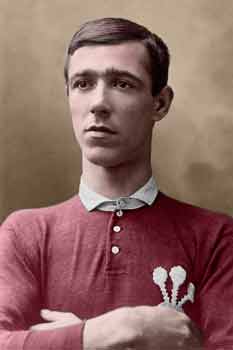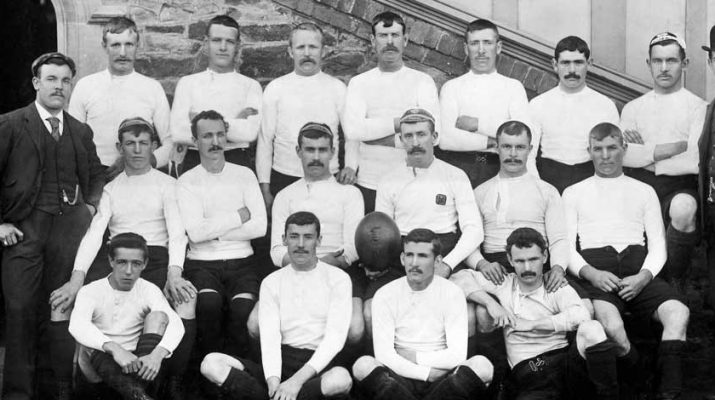The ‘All Whites’ started 1898 with a bang.
After several seasons of underperforming and losing players to ‘northern poachers’, Swansea under the captaincy of Billy Bancroft, at last seemed to be building a side that could consistently attain a high standard of play. The exciting style and silky skills that supporters had craved since the balmy days of Billy Bowen’s tenure and the double Championship of 1889-90 and 1890-91, seemed now within reach again.
 All the pieces were falling into place. Bancroft was a veteran international since 1890 and still Wales’ number one choice at full-back. Now a senior player, his ability to read the game allowed him to calmly guide the team whenever defeat threatened. A heavy and aggressive pack had an established line-up of men who could scrummage, dribble, pass well and, especially in the case of Tom Jackson and the diminutive Sammy Rice, were fiery characters who never took a backward step. Fred Scrine had joined the club and began to craft for himself the position of an attacking back-row forward – years ahead of the New Zealanders’ methods, so well publicised on their 1905 tour.
All the pieces were falling into place. Bancroft was a veteran international since 1890 and still Wales’ number one choice at full-back. Now a senior player, his ability to read the game allowed him to calmly guide the team whenever defeat threatened. A heavy and aggressive pack had an established line-up of men who could scrummage, dribble, pass well and, especially in the case of Tom Jackson and the diminutive Sammy Rice, were fiery characters who never took a backward step. Fred Scrine had joined the club and began to craft for himself the position of an attacking back-row forward – years ahead of the New Zealanders’ methods, so well publicised on their 1905 tour.
David and Evan James, the famed “Swansea gems” had been reinstated since February 1896 after 2 ½ years suspension for professionalism. They were now back to their best form, all the rustiness gone and opponents once again wondering what the brothers would cook up next on the field of play.
The weakness had been in the three-quarters and constant changes in selection never allowed good players to get a settled run. But now finally the young guns were showing their worth. Frank Gordon – the “General” was alert on the wing and taking his chances. The elusive, sidestepping wizardry of Llandeilo man George Davies was creating openings. Dan Rees, that cool, unruffled centre was an old head on young shoulders, in his first season at the club. The centres made deadly use of the wonderful ball and the time to play that the James brothers amply provided.
Out wide a gangly youth called Billy Trew had ousted the speedster Herbie Morgan from the left wing berth. Whereas Morgan was an out and out sprinter, Trew was like an electric eel! Like Dan Rees, he had a natural swerve that was impossible to read. He was an unlikely looking rugby player – he had thin shoulders and a long slender neck and always picked up knocks. But he seemed to have an infinite amount of time with ball in hand. If he could stay fit and polish his game – what a prospect.
Old Merchant Taylors (established by former pupils at the Merchant Taylors’ School in London) were Swansea’s visiting team on 1st January 1898 at St Helen’s. They had a reputation as a useful set of forwards and had taken some good scalps this season in Harlequins, Kensington, Old Leysians and Rosslyn Park. But Swansea had won 12, lost just 2 and drawn 1 match to date and had recently concluded a successful tour, winning away at Leicester and Northampton. Moreover, today was the first time that the classic three-quarter line of Trew, Rees, Davies and Gordon had been selected. Could they produce some magic?
Supporters were shocked to hear before kick-off, that David James was unable to turn out and was replaced at inside-half by Frank Bevan from the seconds. ‘Taylors’ arrived with their regular white kit only, so Swansea had to make do with whatever kit was available and came out of the pavilion wearing “robes of varied hue, blue predominating.” It is reported that Evan James wore his Welsh international jersey from 1892! Bancroft led the team out but was visibly limping, still suffering from the ankle injury picked up against Neath two weeks ago – he had missed the last match, Dai Austin from the seconds taking his place. Early kicking exchanges showed the extent of his discomfort and home supporters muttered nervously. Would their talisman last the distance?
The gloomy mood was lifted after just a few minutes when the Swansea backs opened the game out for the first time: “So far the game had not been

characterised by much brilliancy, but now came a magnificent bit of work which culminated in Evan James running into the visitors’ 25 and passing to Trew, who found a fine opening, and the left-winger putting on extraordinary speed got over and ground[ed] the leather behind the posts. This was an excellent performance, and great enthusiasm prevailed. Bancroft experienced no difficulty in converting.”
5 – Nil!
The ‘All Whites’ forwards began to get the better of their opponents and pressure in the ‘Taylors’ 25 led to a penalty which Bancroft, though “noticeably lame”, slotted over.
8 – Nil

There was rough play as the two packs struggled for supremacy, a visiting player leaving the field with his jersey in tatters and play stopped while he changed. Then as the match restarted: “Evan James received from Bevan about fifteen yards from the Swansea line. The veteran half appeared to fumble, but he quickly recovered himself, and made off round the scrum and passed to Trew. The latter player went off with a bang, and when faced by an opponent transferred back to James. Evan, after a six yard spurt, once more handed to Trew, and the latter went off like a hare and looked like being tackled fifteen yards from the visitors’ line when he threw out to Jackson, and the Swansea forward putting in rare speed, he scored another try. Bancroft negotiated amidst cheers.”
13 – Nil
Continuing to disrupt the visitors’ game, Swansea camped on the goal line, Dan Rees spotting a chance and slipping between defenders to score an unconverted try.
16 – Nil
‘Taylors’ began to put some passes together but were soon pressurised into a kicking game, George Davies and Dan Rees combining to run out of defence as half-time was called.

On restarting, the visitors mounted a determined attack with good footwork by the forwards. But sound defence forced them into a failed attempt at a drop goal. Billy Trew was roughly handled and had to retire, Tom Jackson coming out of the pack and onto the wing! Frank Bevan was now working smoothly with Evan James and the two put the back line in motion again and again as the forwards set up new field positions, their opponents tiring.
A cheer announced the return to the field of young Trew and the Swansea pack now took hold of matters, long-serving Bob Thomas leading a foot rush. ‘Taylors’ tried to respond but their combined play fractured under pressure and Bevan and James again set the backs off, James passing: ” …to Rees, who ran and threw to George Davies, and Gordon, receiving from the centre, play ran down the field, and when hard pressed deftly handed to Rees, who got across and scored a superb try right behind the posts. This was a unique bit of work three parts of the field having been covered during the passing burst.”
21 – Nil

Swansea were now rampant as dusk set in and the supporters squinted to make out the players. Davies and Rees both came close with drop goal attempts before a fluid move put George Davies over, Bancroft adding the extras.
26 – Nil
The visitors made a supreme effort and got down to the corner flag by good passing and seemed sure to score. But, controlled by Billy Bancroft, the Swansea defence again held them out. Off went the Swansea forwards, moving play back into the ‘Taylors’ half. “During a scramble Trew fielded the ball from a kick and running from the touchline towards the posts, the left winger in indescribably brilliant fashion dodged through the bunch and scored in the best position. Bancroft landed the sixth goal, which made the total of points reach the respectable figure of thirty-one.”
Final score:
Swansea 5 converted goals, 1 penalty goal, 1 try, 3 minors (31)
Old Merchant Taylors: 2 minors (Nil)
“Freelance” – our South Wales Daily Post correspondent struggled to describe his impressions on watching Billy Trew’s second try and would have many more head-scratching moments during Trew’s glorious career for Swansea and Wales. At the time of this match only Billy Bancroft, Tom Jackson and the James brothers had achieved their caps. But they would be joined by George Davies, Dan Rees, Billy Trew, Bob Thomas and Hopkin Davies from this day’s line up and many more in the next decade as Swansea finally fulfilled their potential and played a style of attacking football that regularly drew crowds of 15,000 to 20,000 to the famous St Helen’s ground. Every opponent raised their game as Swansea would embark on a run that saw them finish as Welsh Champions 6 times in 7 seasons from 1898 to 1905 and ‘Invincible’ in 1904-05, led by the “General” Frank Gordon.
More championships would follow in 1907-08 and 1912-13 along with historic wins over Australia and South Africa. New starts would arrive – Dick Jones and Dicky Owen even now in the wings as the James brothers had another try at playing ‘up north’.

What’s happening?
A brand new display in the St Helen’s Lounge celebrates this ‘Golden Era’. Supporters can look forward to that and other new displays that the Swansea RFC Archives team have worked on through lockdown. A complete list of Legacy Numbered Swansea players is being compiled, dating from 1872 to the present and celebrating each and every first team player who has served the club.
Rugby may be on hold, but the work still goes on as we prepare for a renewal of the game at St Helen’s. Make sure you keep The Whites in your heads and hearts as we all look forward to the next chapter in this great club’s history.

Thanks to Tony Gemine for our really cool cap stands…


